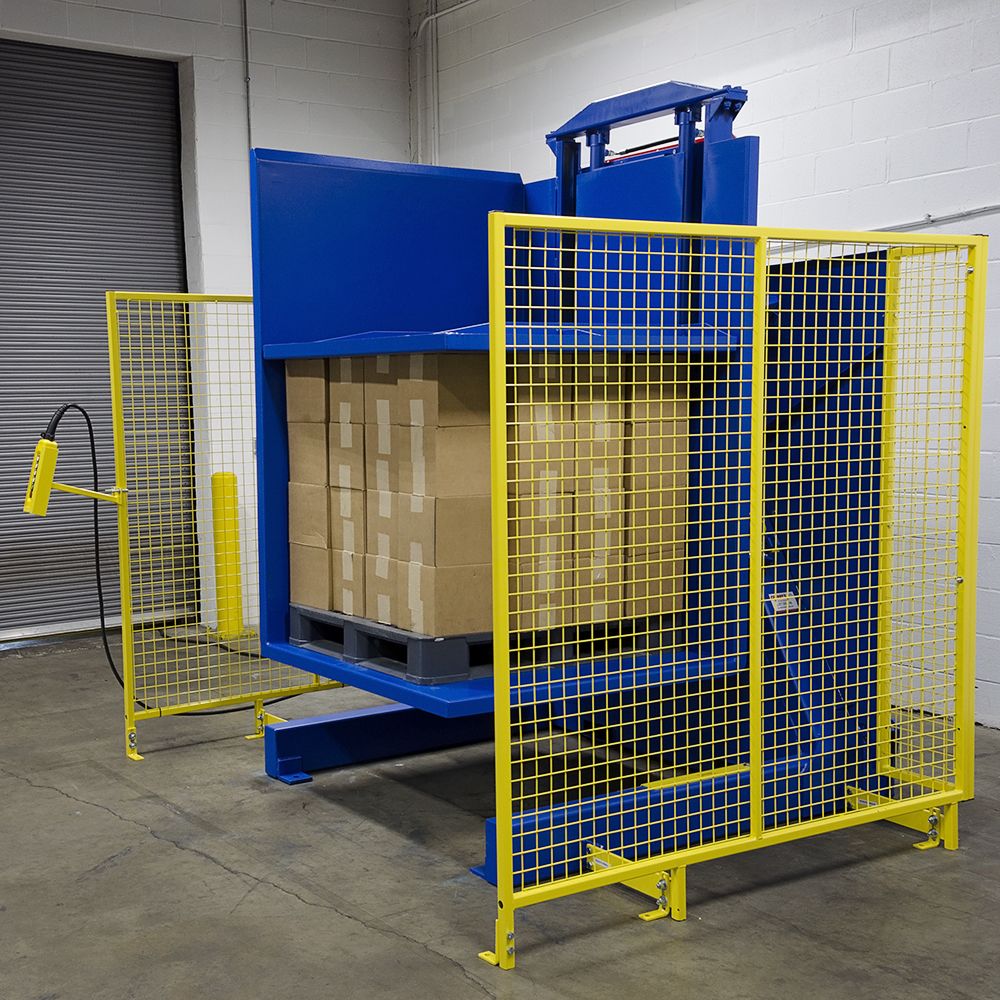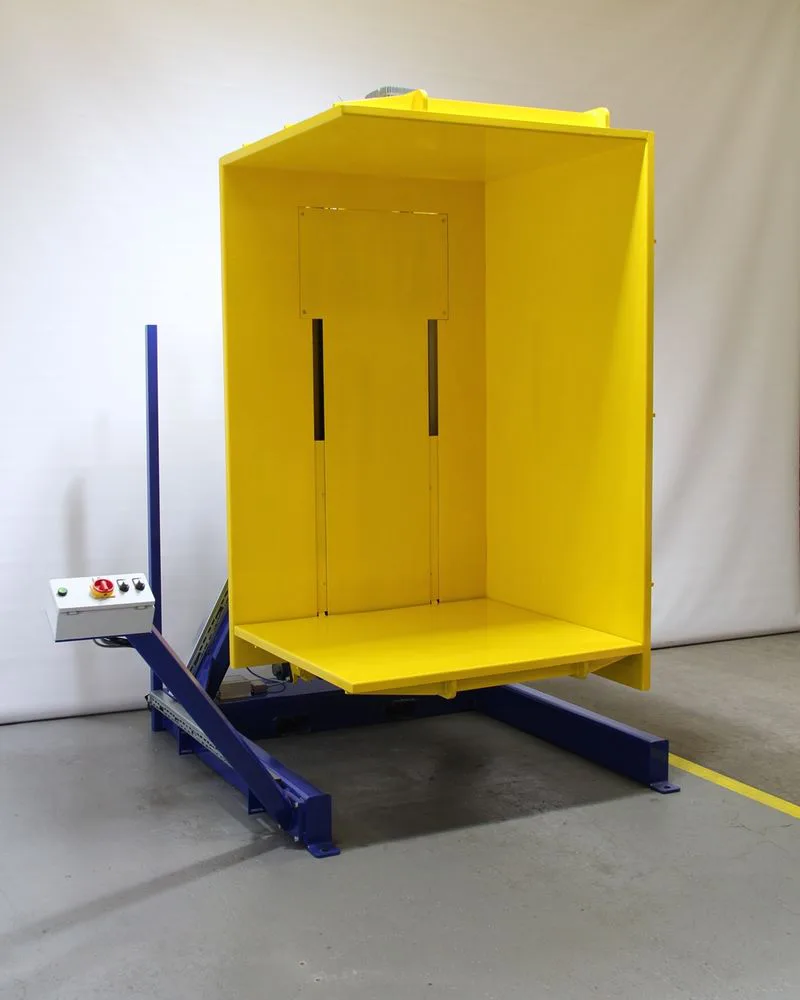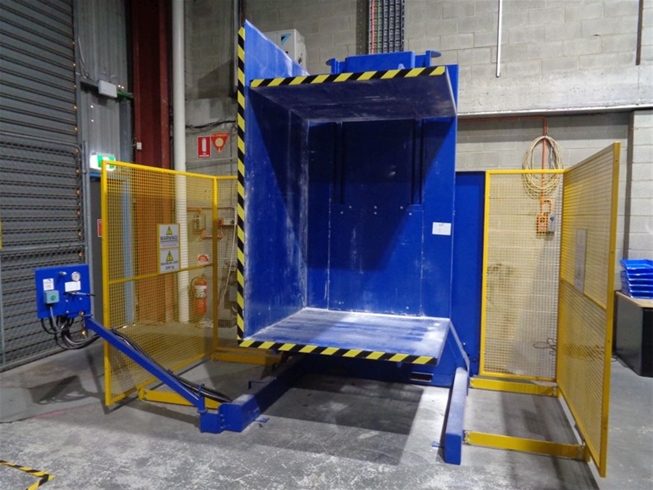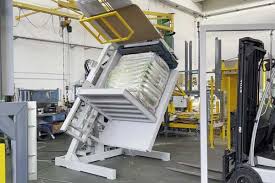Meeting Heat-Resistant Equipment Requirements in Saudi Arabia's Food & Beverage Sector with Automated Pallet Exchange
The food and beverage industry in Saudi Arabia is growing fast. But it faces a unique and difficult challenge: extreme heat. This heat can ruin products, damage equipment, and create unsafe working conditions. Many companies struggle with old, manual processes that are slow and unhygienic. This leads to costly product loss, failed safety audits, and production delays that hurt the bottom line. The constant pressure to maintain quality and safety in such a harsh environment can feel overwhelming. What if there was a way to protect your products, meet strict hygiene standards, and boost efficiency, all at the same time? Automated pallet exchange systems, built specifically for high-temperature environments, offer a powerful solution. They are designed to solve these exact problems.
An automated pallet exchanger is a machine that transfers goods from one pallet to another without manual labor. To meet the demanding requirements of Saudi Arabia's food and beverage industry, these machines are built with heat-resistant materials like stainless steel and use components rated for high temperatures. This ensures they operate reliably in the heat, maintain the highest levels of hygiene required for food safety, and automate a critical step in the logistics chain to improve overall speed and efficiency.

This technology might sound complex, but the benefits are very clear. It is not just about buying a new machine. It is about rethinking your workflow to build a more resilient, efficient, and profitable operation. In my years as an engineer and factory owner, I have seen how the right automation can completely transform a business. Let’s explore how this applies specifically to the challenges and opportunities in Saudi Arabia. We will look at how these machines handle the heat, improve food safety, and what you need to know to choose the right one.
How can automated pallet exchangers handle Saudi Arabia's extreme temperatures?
Your production line is the heart of your business, but the intense Saudi heat puts it under constant stress. Standard equipment, not built for these conditions, often overheats and breaks down. This causes unexpected downtime, which stops production and leads to expensive emergency repairs. You lose money every minute the line is not running. The constant worry about equipment failure in the middle of a critical production run is a heavy burden. The solution is not more repairs; it is investing in equipment that is engineered from the ground up to thrive in extreme heat.
Automated pallet exchangers handle extreme temperatures by using superior materials and components. The frame is often built from high-grade stainless steel, which does not warp or degrade in heat like other materials. Key operational parts, such as motors, sensors, and electrical wiring, are specifically rated for high ambient temperatures. This prevents them from failing when the factory floor gets hot. The design also includes features like proper ventilation and sometimes even cooled control cabinets to protect the most sensitive electronics, ensuring consistent and reliable performance day after day.

The Science of Heat-Resistant Materials
When we talk about equipment for hot climates, the conversation has to start with materials. It's the foundation of reliability. For a pallet exchanger in a Saudi F&B facility, stainless steel is the best choice. But not all stainless steel is the same. Grade 304 is a common, cost-effective option with good corrosion resistance. However, for facilities with high humidity or those using harsh cleaning chemicals, I always recommend Grade 316L. It has added molybdenum, which gives it superior resistance to chlorides and other corrosive agents. This means it lasts longer and stays hygienic. The material's ability to handle thermal expansion without losing its structural integrity is critical. A machine built with the wrong metal can literally tear itself apart from the daily cycle of heating and cooling.
Components Engineered for the Heat
A strong frame is just the beginning. The components doing the work must also be up to the task. I've seen clients buy a machine that looked good on the outside, only to have it fail because the internal parts were not specified for the heat. Here’s what to look for:
- Motors: Look for motors with a higher insulation class (like Class H), which are designed to operate at higher internal temperatures without burning out.
- Electronics: Sensors, PLCs, and wiring must be rated for high ambient temperatures, often up to 50°C (122°F) or more. Control cabinets should be well-ventilated or, in extreme cases, equipped with a small air conditioning unit to keep the electronics stable.
- Hydraulics and Pneumatics: The seals and hoses in these systems are often the first things to fail in the heat. High-temperature rated seals made from materials like Viton are essential to prevent leaks and system failure.
| Component | Standard Specification | Heat-Resistant Specification | Why It Matters in Saudi Arabia |
|---|---|---|---|
| Frame Material | Painted Mild Steel | Stainless Steel (304 or 316L) | Prevents rust and warping in heat and humidity. |
| Motor | Class F Insulation | Class H Insulation | Handles higher operating temperatures without failure. |
| Sensors | Standard Temp Rating (up to 40°C) | High-Temp Rating (up to 60°C+) | Ensures accurate machine function when facility is hot. |
| Hydraulic Seals | Nitrile (Buna-N) | Viton (FKM) | Prevents leaks as heat makes standard seals brittle. |
| Control Cabinet | Fan-Vented | Air-Conditioned or Heat-Shielded | Protects sensitive PLCs from heat-induced errors. |
What are the key food safety benefits of using stainless steel pallet exchangers?
In the food and beverage industry, contamination is the biggest fear. A single incident can lead to a massive product recall, destroying consumer trust and resulting in huge financial losses. Old wooden pallets are a major source of this risk. They absorb moisture, splinter, and can harbor mold, bacteria, and pests. Manually moving products from these external pallets to internal, clean pallets is slow and creates opportunities for human error and contamination. This constant risk puts your brand and your compliance with bodies like the Saudi Food and Drug Authority (SFDA) in jeopardy. A stainless steel pallet exchanger removes this threat by creating a clean, automated, and controlled transfer point.
The key food safety benefits of using a stainless steel pallet exchanger are centered on hygiene and control. First, it allows you to completely separate outside pallets from your clean production environment, eliminating a primary source of contamination. Second, the stainless steel construction is non-porous, easy to clean, and resists bacterial growth, making it simple to maintain the highest sanitation standards. Third, the automated process minimizes human contact with the product, reducing the risk of cross-contamination and ensuring compliance with strict food safety regulations like HACCP and SFDA.

Creating a Fortress Against Contamination
Think of your receiving dock as a gateway. Every pallet that comes in from an outside truck is a potential threat. I once worked with a beverage company that was struggling with random spoilage issues they couldn't trace. We discovered that incoming wooden pallets, which often sat outside in the heat and rain, were the source of mold spores. The solution was to establish a clear barrier. We installed a pallet exchanger at the receiving dock. All incoming goods on wooden pallets were automatically transferred to their internal, sterilized plastic pallets. The wooden pallets never entered the main facility. This single change eliminated their spoilage problem. The pallet exchanger acts as a guard, ensuring only clean, safe pallets enter your sensitive production areas.
Hygienic Design: More Than Just Shiny Metal
Stainless steel is the ideal material, but the machine's design is just as important for food safety. A truly hygienic design goes deeper.
- No Crevices: The machine should be designed with smooth surfaces and welded joints, eliminating tiny cracks or corners where bacteria can hide and multiply.
- Open Frame: An open-frame construction allows for easy access for cleaning. Your sanitation crew should be able to easily spray down and wipe every part of the machine.
- Chemical Resistance: As I mentioned, Grade 316L stainless steel is crucial if you use strong, corrosive cleaning agents. The machine must be able to withstand daily washdowns without degrading.
This level of detail is essential for meeting international food safety standards.
| Pallet Type | Hygiene Risk Factor | How Pallet Exchanger Solves It |
|---|---|---|
| Wood Pallets | High (Porous, Splinters, Mold) | Enables transfer to clean pallets at entry point. Wood never enters the facility. |
| Rental Plastic Pallets | Medium (Unknown history, scuffs) | Allows use of a dedicated, internally controlled and cleaned pallet pool. |
| In-House Plastic/Metal | Low (Controlled, Cleanable) | The pallet exchanger makes using and managing this ideal pallet type practical. |
By automating the transfer process with a hygienically designed machine, you are not just improving efficiency; you are building a robust defense system for your products and your brand.
How does pallet exchange automation boost efficiency in Saudi F&B logistics?
Relying on manual labor to transfer goods from one pallet to another is a major bottleneck in any fast-paced logistics operation. It is slow, physically demanding, and inefficient. In the hot climate of Saudi Arabia, the problem is even worse. Workers tire more quickly, leading to slower work and a higher risk of costly mistakes or injuries. This manual process holds back your entire production line, limiting your throughput and increasing your labor costs. You have a factory full of high-speed equipment, but it's all waiting on a slow, manual step. To truly unlock your plant's potential, you need to automate this critical link in the chain.
Pallet exchange automation boosts efficiency by replacing a slow, manual process with a fast, reliable, and continuous machine cycle. A task that could take two workers 15 minutes to do by hand can be completed by a pallet exchanger in about 60 to 90 seconds. This massive increase in speed eliminates bottlenecks at receiving and shipping. It also reduces the need for manual labor, allowing you to reassign your team to more valuable tasks. By automating, you create a smooth, predictable workflow that operates 24/7 with minimal product damage and maximum throughput.

The Numbers Don't Lie: A Leap in Throughput
Let's look at a simple example. Suppose you need to transfer 20 pallets in an hour.
- Manual Method: Two workers might take 15 minutes per pallet. This means they can only handle 4 pallets per hour. To handle 20, you would need 5 teams of two workers, a total of 10 people, just for this one task.
- Automated Method: A pallet exchanger with a 90-second cycle time can handle 40 pallets per hour. One operator can oversee the process.
The difference is staggering. The automation not only gets the job done faster but does it with a fraction of the labor. This is a direct impact on your operational costs and your capacity to handle more volume as your business grows. I remember a client who ran two shifts and was considering adding a third just to keep up with demand. After installing a pallet inverter and a wrapper, they were able to meet their targets in just one and a half shifts, saving them a huge amount in overtime and labor costs.
A Safer Workplace and a More Valuable Team
The benefits go beyond just speed. Manual re-stacking of heavy boxes is a leading cause of back injuries in warehouses. In a hot environment, the risk of heat exhaustion and other health issues is also very high. Automation removes this dangerous, repetitive work. It creates a safer workplace, which reduces employee turnover and insurance costs. It also frees up your team members. Instead of performing manual labor, they can be trained to operate machinery, manage inventory using a WMS, or perform quality control checks. You transform a labor cost into a skilled asset for your company.
| Metric | Manual Pallet Transfer | Automated Pallet Exchange | The Impact |
|---|---|---|---|
| Time per Pallet | 15-20 minutes | 60-90 seconds | Massive increase in throughput |
| Labor Required | 2+ workers per pallet | 1 operator for the line | Drastic reduction in labor costs |
| Worker Safety | High risk of injury | Low risk of injury | Improved morale, lower insurance costs |
| Product Damage | High risk of drops/spills | Minimal risk | Reduced product loss and waste |
| Consistency | Varies by worker and time of day | Perfectly consistent 24/7 | Predictable, reliable operations |
What should you look for when choosing a pallet exchange solution for a hot climate?
You are convinced that automation is the right move. But choosing the right machine can be difficult. Making the wrong choice is a very expensive mistake. A machine that is not suited for your specific product, pallet types, and, most importantly, your hot climate will cause endless problems. It will break down, disrupt your production, and fail to deliver the benefits you were promised. It becomes a liability instead of an asset. To avoid this, you need to go into the selection process with a clear understanding of what really matters, looking beyond the initial price tag to find a true long-term solution.
When choosing a pallet exchange solution for a hot climate like Saudi Arabia, you must prioritize four key areas. First, verify the machine's construction and materials, ensuring it uses heat-resistant components and high-grade stainless steel. Second, confirm its hygienic design is suitable for food safety and easy cleaning. Third, insist on robust safety features like light curtains and emergency stops to protect your workers. Finally, and perhaps most importantly, choose a supplier who acts as a partner, offering strong local support for installation, training, and maintenance.

Your Technical Checklist for a High-Performance Machine
Before you even talk about price, you need a technical checklist. This is non-negotiable for an operation in a hot, food-grade environment.
- Material Grade: Is it Stainless Steel 304 or 316L? Ask for material certifications.
- Component Ratings: What is the maximum ambient temperature rating for the motors, sensors, and PLC? Demand proof from the manufacturer's spec sheets.
- IP Rating: The Ingress Protection rating tells you how well the electronics are sealed against dust and water. For a washdown environment, you need at least IP65.
- Capacity and Handling: Can it handle your maximum load weight? Is it adjustable for different pallet or product sizes?
- Safety Systems: Does it have certified safety systems (like light curtains, pressure mats, or physical guarding with interlock switches) that meet international standards?
I always tell my clients, "Be the difficult customer during the sales process, so you don't have a difficult time after installation." Ask these tough questions upfront.
Why a Partner is Better Than a Supplier
This is a lesson I learned early in my career. A supplier sells you a box. A partner helps you find a solution. The cheapest machine from a distant manufacturer with no local presence is a huge risk. What happens when you need a spare part urgently or require technical support? A true partner, like we strive to be at SHJLPACK, will work with you through the entire process:
- Consultation: They will analyze your specific needs to recommend the right machine, not just the most expensive one.
- Installation & Commissioning: They will have trained technicians to ensure the machine is installed and set up correctly.
- Training: They will train your operators and maintenance staff properly.
- After-Sales Support: They will have a local or regional presence to provide fast support and spare parts.
The value of this support over the 10-15 year life of the machine is far greater than any small savings on the initial purchase price.
My Insight as an Engineer
Over my 20+ years in this industry, from working on the factory floor to building my own company, I've seen technology change everything. But one thing has stayed the same: the companies that succeed are the ones that look ahead. They don't wait for a problem to become a crisis. They invest in solutions that give them a competitive edge.
In demanding environments like Saudi Arabia's F&B sector, automation like a pallet exchanger is no longer a luxury. It is becoming a fundamental requirement for success. The combination of extreme heat, strict food safety laws, and the need for high efficiency creates a perfect storm where old, manual methods simply cannot keep up.
Investing in robust, heat-resistant, and hygienic automation is not just an operational upgrade. It is a strategic decision. It tells your customers that you are serious about quality. It tells your employees that you are serious about their safety. And it tells your competitors that you are serious about growth. From my experience, the companies that make these investments early are the ones who become leaders in their market.
Conclusion
In Saudi Arabia's F&B market, automated, heat-resistant pallet exchangers are a strategic necessity for ensuring hygiene, boosting efficiency, and driving sustainable growth in a demanding environment.



